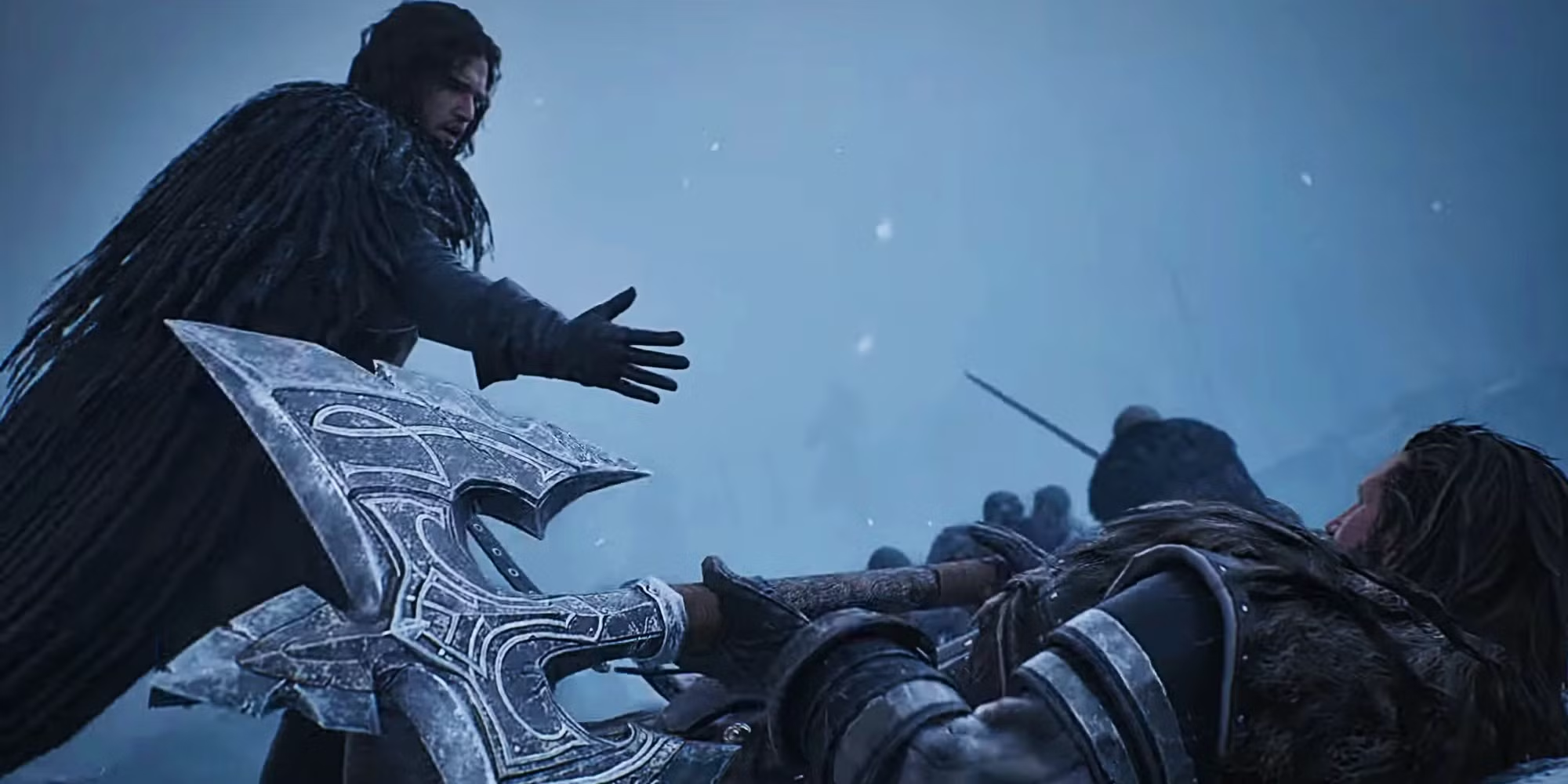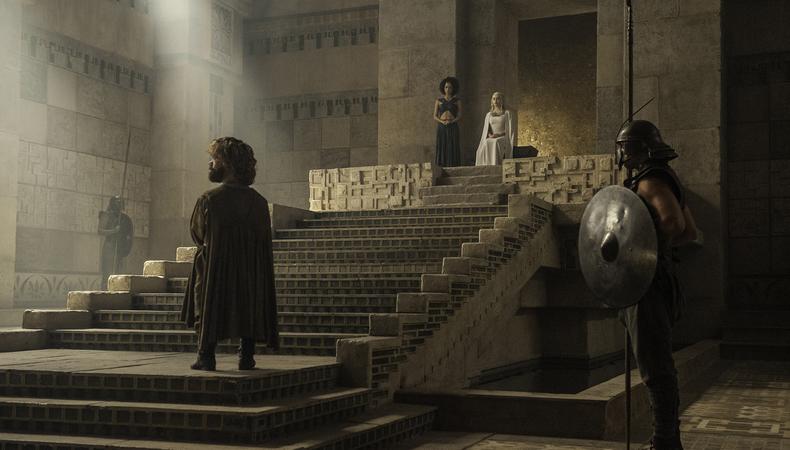Photo Source: Helen Sloan/courtesy of HBO
From Dragonstone to Meereen, the sets for HBO’s “Game of Thrones” were epic locations that helped transport actors as well as viewers to Westeros for eight seasons. Leading the way to work this magic behind the scenes was production designer Deborah Riley, who joined the series on Season 4. Her work on the show earned her four Emmy wins for outstanding production design and a final nomination earlier this year. It’s an impressive count for her first foray into TV after working on films like “The Matrix,” “Moulin Rouge!” Now she’s capping off the end of the epic fantasy series with the release of the HBO and Insight Editions book “The Art of ‘Game of Thrones’ ”, due November 2019. We caught up with Riley at New York Comic Con earlier this month to learn more about her award-winning work on “Game of Thrones” and how it all comes together on set.
READ: Casting Details for ‘Game of Thrones’ Prequel Series
How would you describe the role of a production designer on a TV set?
The production designer is responsible for the sets and the props. That means I work very closely with the producers, directors, cinematographers, construction manager, all of those people. [I] have a great team of art directors, props makers, painters, and plasterers. We all work together to make a cohesive environment for the show to be set in and that means that we would either be working on location or building a set on stage, which in the case of “Game of Thrones” was based in Northern Ireland. The locations were also in all different countries, so we were either in Iceland, Croatia, Spain, or Northern Ireland itself. It’s a fantastic job. It means you’re head of the art department, helping make beautiful images to set the story in.
How do you interact with the different departments and the actors themselves? What is the process like?
On every project it’s different, but certainly on “Game of Thrones” it all started with an outline which our showrunners David [Benioff] and Dan [Weiss] would issue at the start of every season. Then from there, the producers and I would break that down and work out what was assumed to be a location build or what was assumed to be on stage in Belfast. From there, we would just start going on location scouts, having a look at what we could find, working out what the builds would be and how to break it all down, and then you just start at the start. As the directors come into it, they also have comments about how they see the shape of the scene and the cinematographers might also have an idea at that point about how to film it. As the set design evolves, it becomes more and more intense with the directors and the DPs.
As the build goes ahead, as we get budgets and timelines signed off, that’s the thing. It’s money and time. It always comes down to money and time. Once we’re on our way, everybody comes through and checks it. You get the directors who come and visit it as its being built, and so by the time we get to the first day of shoot or rehearsals, everybody knows what it is. They’ve all seen it before. It’s been camera tested and we’re all ready to go. It’s a long process. Sometimes on “Game of Thrones” it was really fast, depending on the size of the set, and sometimes it was quite slow and took a long time to develop. Crucially, there’s one stage of the process with the concept designers. Those concept artists create images that are signed off and that’s really what we’re trying to achieve is the physical manifestation of those illustrations and that’s what that “Game of Thrones” art book is really. It’s just a beautiful collection of all the concept art.
So when the actors arrive to film a scene, is that usually the first time they’re interacting with your designs?
Yes, unless there’s been a rehearsal first. Basically we just sort of stay with the producers, directors, and DPs, and on the morning of the shoot, when the actors walk in for rehearsal, that will usually be the first time. By that time I’ve like, run out the door and I’m working on the next one. It’s quite fast. I never really got the luxury of standing around and watching very much.
You’ve also worked in films. Is that process different from TV?
The biggest difference is just time. On a TV schedule, you’re just working so fast. On a feature film, maybe the script would be 100 or 110 pages long. I’ll never forget on my first season of “Game of Thrones,” which was Season 4, there were 600 pages. Not only do you have to create more, but you’ve got less time to do it. So that’s the biggest difference. In terms of finishes and the quality of it, that all had to be the same. It was quite a learning curve for me. I just had to work really fast. Communication is the key, too.
READ: ‘Game of Thrones’ CD Nina Gold Shares What She Looks for in Auditions
Coming in on Season 4, there had been designs established on the show already, but you also had to create new locations from the books. What was it like working on these sets and coming up with these designs where you had to work with both these factors?
For me, it worked out perfectly because I didn’t have much experience coming into the show, so the fact that Gemma [Jackson] had already established a look and a feel was something that really gave me a lot of confidence because I knew that there was something that I could bounce off. It was a really fortunate thing for somebody at this stage of my career where I was at the time that I could then take it and make it my own as the show kept on expanding, but that there was something already established and approved and I could very easily understand how that art department was working. When I was auditioning and interviewing for the job, it was very clear they were introducing a new conductor. They weren’t changing the whole orchestra. So the main thing I had to do was work with the people who already were in Belfast and had done three years of the show. I was so lucky to inherit such a talented group of people and over the next five years, I became incredibly close to them. It couldn’t have been better.
What kind of insight does this book provide into your work and process? What was it like putting all of it into book form?
It was like a real trip down memory lane. It’s like a family album, in a sense, because it takes you back to a time and a place and the artists who drew it and what we were doing at the time. Most of all, it’s a real tribute to them because it’s a book full of all the concept art, and that’s a very crucial stage in the design process. I was lucky to have a lot of the same artists with me over all of those years. It’s a book that’s full of their work and I just can’t wait for them to see it. A couple of months ago we were running through all the artwork again, but once they get it in their hands it’s going to be a completely different thing. It’s a wonderful opportunity for all of us.
Looking back, do you have any favorite sets you worked on?
To this day, I still get quite emotional thinking about the Meereen audience chamber, and that was way back in Season 4 because that was the first really big set that we built. It was the first sort of new look that the new art department had been able to give the show, and I was very nervous about my position at that point. Then once that was built, it was like, I’m going to be fine. It was a relief to survive. I’ll never forget that one for that. Before it was brought down, I went and said a little quiet goodbye to it because I was very fond of it. Working all the way through to Dragonstone, I loved. Even what we did in Season 8, it was such an emotional experience not only in terms of the story we were telling but in terms of the art department. To build something and then destroy it, and to destroy this throne room that had been standing for so many years, I found it quite traumatic to do all of that.
Want to hear more from the best creators in film, TV, and theater? Get it right here!




















![[Book Review] The Blade Itself (The First Law Trilogy) by Joe Abercrombie](https://bendthekneegot.com/wp-content/uploads/2018/01/1516047103_maxresdefault-218x150.jpg)


















